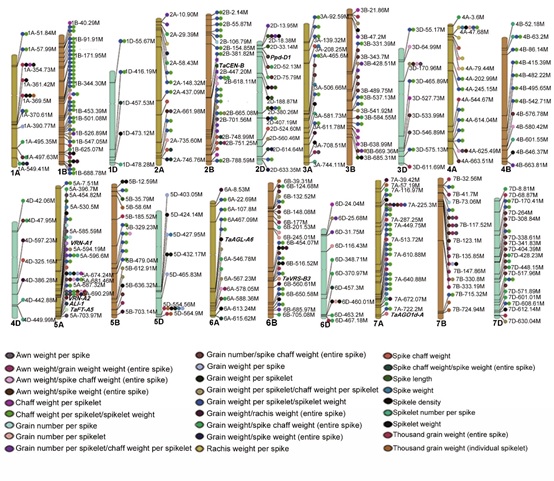Large-scale genotype-phenotype association studies of crop germplasm are important for identifying alleles associated with favorable traits. The limited number of single nucleotide polymorphisms (SNPs) in most wheat genome-wide association studies (GWASs) restricts their power to detect marker-trait associations. Additionally, only a few genes regulating grain number per spikelet have been reported due to sensitivity of this trait to variable environments.
A research team led by Prof. GUO Zifeng from the Institute of Botany of the Chinese Academy of Sciences (IBCAS) with collaborators performed a large-scale GWAS using approximately 40 million filtered SNPs for 27 spike morphology traits.
They detected 132,086 significant marker-trait associations and the associated SNP markers are located within 590 associated peaks. They detected additional and stronger peaks by dividing spike morphology into sub-traits relative to GWAS results of spike morphology traits.
Researchers proposed that the genetic dissection of spike morphology is a powerful strategy to detect signals for grain yield traits in wheat. The GWAS results revealed that TaSPL17 positively controls grain size and number by regulating spikelet and floret meristem development, which in turn leads to enhanced grain yield per plant. The haplotypes at TaSPL17 indicated geographical differentiation, domestication effects and breeding selection.
“This study provides valuable resources for genetic improvement of spike morphology and a fast-forward genetic solution for candidate gene detection and cloning in wheat,” said Prof. GUO Zifeng, one of the corresponding authors.
These results entitled “A high-resolution genotype–phenotype map identifies the TaSPL17 controlling grain number and size in wheat” was published in Genome Biology on August 28, 2023.

Article Link: https://genomebiology.biomedcentral.com/articles/10.1186/s13059-023-03044-2
Contact:
Prof. GUO Zifeng, guozifeng@ibcas.ac.cn
The Institute of Botany, Chinese Academy of Sciences
Large-scale genotype-phenotype association studies of crop germplasm are important for identifying alleles associated with favorable traits. The limited number of single nucleotide polymorphisms (SNPs) in most wheat genome-wide association studies (GWASs) restricts their power to detect marker-trait associations. Additionally, only a few genes regulating grain number per spikelet have been reported due to sensitivity of this trait to variable environments.
A research team led by Prof. GUO Zifeng from the Institute of Botany of the Chinese Academy of Sciences (IBCAS) with collaborators performed a large-scale GWAS using approximately 40 million filtered SNPs for 27 spike morphology traits.
They detected 132,086 significant marker-trait associations and the associated SNP markers are located within 590 associated peaks. They detected additional and stronger peaks by dividing spike morphology into sub-traits relative to GWAS results of spike morphology traits.
Researchers proposed that the genetic dissection of spike morphology is a powerful strategy to detect signals for grain yield traits in wheat. The GWAS results revealed that TaSPL17 positively controls grain size and number by regulating spikelet and floret meristem development, which in turn leads to enhanced grain yield per plant. The haplotypes at TaSPL17 indicated geographical differentiation, domestication effects and breeding selection.
“This study provides valuable resources for genetic improvement of spike morphology and a fast-forward genetic solution for candidate gene detection and cloning in wheat,” said Prof. GUO Zifeng, one of the corresponding authors.
These results entitled “A high-resolution genotype–phenotype map identifies the TaSPL17 controlling grain number and size in wheat” was published in Genome Biology on August 28, 2023.

Article Link: https://genomebiology.biomedcentral.com/articles/10.1186/s13059-023-03044-2
Contact:
Prof. GUO Zifeng, guozifeng@ibcas.ac.cn
The Institute of Botany, Chinese Academy of Sciences
